
Islamabad: The number of rejected ballots was greater than the margin of victory in at least 24 National Assembly constituencies, according to an interesting statistical nugget from Pakistan’s recent general elections.
The difference potentially opens doors for legal battles as several losing candidates have flooded the courts with petitions to review the results.
According to a report in the Dawn newspaper, 22 constituencies with a greater number of rejected votes than the margin of victory fell in Punjab, with one each in Khyber Pakhtunkhwa and Sindh province.
The Pakistan Muslim League-Nawaz (PML-N) won the electoral race in 13 of these constituencies, five were claimed by the Pakistan People’s Party (PPP), four by the Pakistan Tehreek-e-Insaf (PTI)-backed independents and two by other independents.
Going by their numerical strength, both the PML-N and the PPP are in a position to form a coalition government in the Centre. However, PML-N supremo Nawaz Sharif announced that all parties except PTI should join hands in the upcoming coalition set-up.
According to the results announced by the Election Commission of Pakistan (ECP) till Sunday, of the total 265 National Assembly seats, PTI-backed Independents bagged 93 seats, followed by PML-N at 73, PPP at 54, MQM at 17 and others at 19.
The highest number of rejected votes was in the NA-59 (Talagang-cum-Chakwal) area of Punjab where Sardar Ghulam Abbas of PML-N secured 141,680 votes against his closest rival PTI-backed Muhammad Ruman Ahmad, who got 129,716 votes.
The margin of victory was 11,964 while the number of ballot papers rejected was 24,547.
It was followed by NA-213 Umerkot (17,571 ballots). The lowest number of ballots excluded are reported from NA-236 Karachi East-II (51 ballots).
In total, around two million ballot papers have been excluded from the count from the 265 National Assembly constituencies.
As many as four constituencies have more than 15,000 excluded ballots each. Another 21 constituencies have excluded 10,000 to 15,000 ballots. A large number of constituencies (137) reported excluded votes in the range of 5,000 to 10,000.
A total of 67 constituencies have reported fewer than 5,000 but greater than 1,000 excluded ballots. Only six constituencies have reported fewer than 1,000 excluded ballots each.

